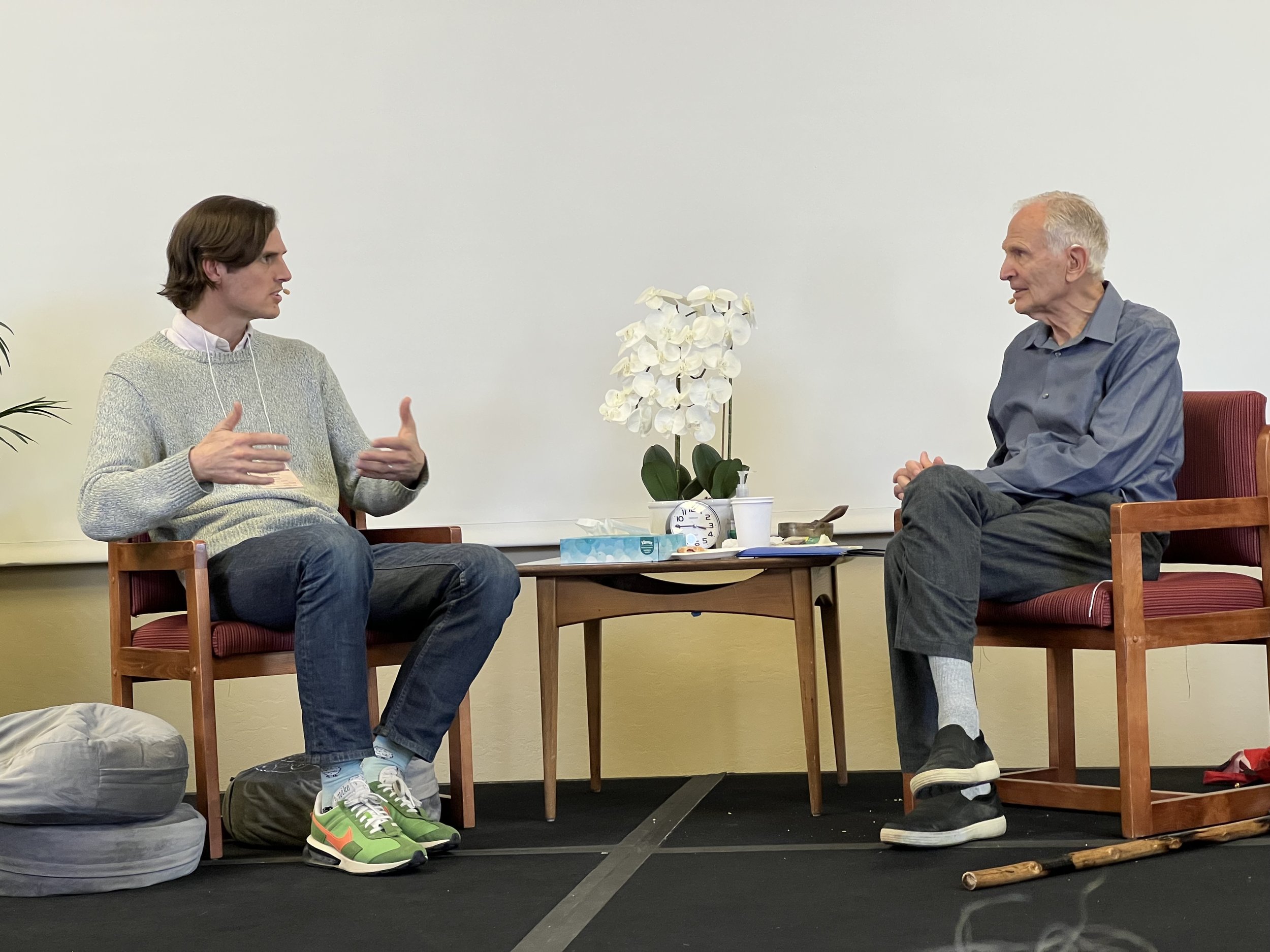Tidbits Garnered at the Feet of Peter Levine, Founder of Somatic Experiencing
Yes! For the past week, I sat on a small pillow on the ground, just a few feet in front of Peter Levine as he worked with about 12 clients on the topic of chronic pain and syndromes.
So for starters, let’s just say there was a LOT of energy in the room. The sessions were magnetic and entrancing. These folks REALLY wanted to heal and there was a lot going on in each of them. A big part of the event was having one hundred empathetic nervous systems witness each human struggle unfold.
Peter appeared rigorous and scientific, yet also a tie-dyed-in-the-wool humanist with an extremely positive view on human nature and healing. With his 81 years of age, long staff, strident and mysterious manner, and frequent chin-stroking he gave off some strong wizard-vibes.
Over the week, I collected the following juicy tidbits that fell off the stage.
At one point I did join Peter on the stage briefly for a case consultation. I made sure to land one of my best somatic gestures for the camera. ;-)
Peter’s Hodgpodge List of Juicy Tidbits
When it appears, always go with the vitality. The goal of Somatic Experiencing is not to erase trauma or learn how to manage trauma better. The goal is to bring out aliveness, i.e. to draw forth a person’s life-force, vitality, flow, and forward movement in life.
Trauma is what we had to hold inside in the absence of an empathetic other.
If you survived, you must have life-force.
In working with syndromes, titration of painful sensations becomes “microtitration.”
Therapy is a series of gradually escalating confrontations.
Long-term pain almost always comes from a pattern of fear and bracing. Fear, bracing, pain, fear, bracing, pain, etc. A feedback process called “kindling” leads to the fear-bracing-pain neural pathway growing and spreading both over the brain and over time. Chronic pain often starts because acute pain is not adequately medicated, which starts the process of kindling.
There are many sub syndromes, but one global Syndrome that connects throughout the nervous system. “There is 80% overlap with most mind-body syndromes.”
Almost all mind body syndromes involve vagus nerve dysfunction. The vagus is the longest nerve in the body connecting the brain, heart, lungs and digestion and 80% of the fibers travel from viscera to brain. When the vagus is offline, the body is “unsafe” and dysregulated.
Regulation is when the sympathetic and parasympathetic systems are coordinating reciprocally to bring homeostasis, or the appropriate energy level to the situation. Trauma disrupts this coordination, keeping us stuck-on, stuck-off, or cycling.
Breathing is just inflating and deflating the lungs whereas respiring is the full energy cycle that includes bloodflow picking up oxygen and carrying it to all the cells, mitochondria in the cells producing metabolic energy, and bloodflow removing carbon dioxide. Trauma disrupts the full respiration process, not just breathing.
Syndromes usually result in hypo- or hyper-ventilation (too little or too much breathing). Exercises like box breathing only bring temporary relief and then the breathing pattern usually returns. The best way to reset organic or “easy” breathing is making the “voo” sound and feeling for any shift. Actually, for pretty much everything, the voo appears to be number one on Peter’s list.
Tremors, shaking and tingling are often regarded as a negative symptom when actually this is the body working to resolve the issue.
Flow is the antidote to pain. Pain and flow can’t exist at the same time. Getting into an intuitive swaying movement is a simple way to experience flow. The neural underpinning of flow is cerebellar rhythm (the cerebellum being the part of the brain that coordinates movements).
As we experience more safety, bracing reduces, the container of the body expands, and deeper energy wells are unlocked.
Boundary setting is the first step in relational work. “I can’t have a safe relationship until I have boundaries.”
ADHD appears to be an adaptation to stay away from an underlying collapsed or shut down emotional state.
Anxiety is excitement that’s been blocked.
If you’re getting stuck with a movement that’s not feeling authentic, simply “fake it till you make it” so that you can have a different experience and get new information.
As a practitioner do not encourage the shamanic transference, where the healer is viewed as magical or mystical. Instead, give straight-forward and practical explanations for what you are doing. “It’s better in the long run.”
Intuition needs to be informed by and checked against facts constantly.
Resonance happens when we connect from “somasphere to somasphere, or from one interoceptive landscape to another.”
Dreams after sessions often reflect developments that happen later, say in 4-6 months, such as moving with more fluidity.


